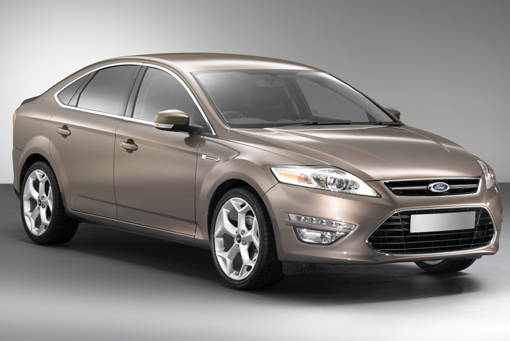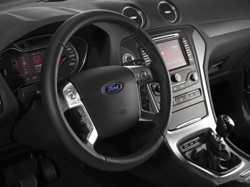Ford Mondeo
It has long been a staple of family men and sales reps. Frederic Manby takes a look at the latest Ford Mondeos.
THE Mondeo is Ford’s largest car in Europe. It is big enough for most of us. In Britain, eight in every 10 are bought by companies and it takes 25 per cent of its market.
It still makes a good car for the private buyer – and don’t forget to bargain, because bulk buyers do. Just don’t expect a lot off, because Ford is bouncing back into profit after stringent housekeeping.
In America, the company has been transformed by its CEO, Alan Mulally, now a 65-year-old, who joined after 37 years with Boeing. Dubbed a non-car guy, he proved that you don’t need to be a car buff to do emergency rescue work Where General Motors and Chrysler Jeep imploded, Ford came through as Mr Mulally cut jobs, closed factories and sold off the European glamour brands of Aston Martin, Jaguar, Land Rover and Volvo. At home, the Mercury badge was ditched, leaving Ford and Lincoln.
In the second quarter this year, Ford had pre-tax operating profit of $2.9bn. The same quarter last year showed a $424m loss. Now he is moving things on with the slogan One Ford…
It is another attempt at the global car, so that all markets use essentially the same design. The new Focus, for example, has 85 per cent common parts in all its markets. Something similar will happen to the Mondeo, being relaunched now in Europe in its mid-life revamp.
Mondeo has been praised for its road manners since the first one in 1993, and British sales have reached 1.3m. The 2007 model sold 120,000, many of them at fleet discounts. It is a type of car that has slid out of favour. In 1998, it led its segment.
Not any longer. Vauxhall’s German-built Insignia has usurped the Belgian Mondeo, as hasBMW’s smaller but more prestigious 3-series.
Ford wants a different perception for Mondeo, to move it up a notch. In line with Mulally’s strictures, the saloon version is dropped in Britain because we didn’t buy many, leaving the more practical hatchback and the load-friendly estate. Prices are, mostly, unaltered (from £17,295).
Headline news includes a more restrained face, with a slimmer top grill and a wider lower intake which gapes a la mode Peugeot. These shapes make the Mondeo front look less like a Ford. I think buyers will be attracted. There are LED running lamps on the high-grade models and a reprofiled bonnet, with subtler changes at the back, where the wider LED lamps visually shrink the boot lip.
Inside, the Mondeo team, led by Sheffield-born Marin Smith (executive director of design at Ford Europe), has given a clearer and less fussy
instrumentation and soft-touch switches. The overhead lights are moved back in the roof, a small move but more logical, with a bright LED beam. It makes, say, routes easier to see if you still use a map.
There is a new quality in the touch and feel. Example: The closure of the lid on the central locker uses spring assistance in its last inch, obviating the need for a mechanical latch.
There are new engines with more power and lower emissions and better mileage. These include a 2-litre petrol turbo in 203ps and 240ps “Ecoboost” tune which will be small players because nine out of 10 Mondeos will have diesel motors. A 160ps 1.6 petrol of interest to private and business users with low C02 is on the way.
The paramount diesel is the new 2.2 litre with 200ps and masses of torque. It is the most beefy diesel to date in a Ford car. Like the powerful new Ecoboost turbo petrol engines it will be sold only with the higher trim grades, giving Ford a decent income on relatively low sales.
This Mondeo is the first to get the option of active safety systems, such as “driver alert” which warns you of drowsiness by monitoring your posture. Signals include the picture of a steaming cup – the same emblem used by Volvo on its latest S60.
Another option warns if you are drifting over the white line. You may also specify automatic dipping of the headlamps.
The 203ps, 240ps and 2-litre diesel engine introduce active air intakes to the non-premium market. By monitoring the cooling demands of the engine, this closes as much as 85 per cent of the vanes on the lower grille. There are 15 levels of closure, depending on criteria such as speed, engine fluid temperatures, demands of the cabin air conditioning and so on. At full closure, it achieves a six per cent gain in streamlining, helping pace/economy.
The engines available for testing were the 240ps Ecoboost and the 200ps 2.2 diesel. The Ecoboost has a standard-fit, six-speed Tiptronic automatic twin clutch gearchange. It covers 0-62mph in 7.5 seconds and is rated at 36mpg and 179g/km CO2.
These are considerable improvements on the old 2.3 automatic, and Ford’s plan is they will be good enough to rival the attraction of diesel.
It is a curious rationale because although this petrol motor sounds sweet and smooth and sporting, there is the allure of the new 2.2 diesel, which with stacks more torque, is a match for the Ecoboost. It has a 0-62 time of .8.1 seconds, can reach 143mph, and is rated at 47mpg and 159g/km CO2.
Then there are the 2-litre diesels in 115, 140 and 163ps tune, all rated at less than 140g/km. The 140 and 163ps motors are available with the six-speed automatic gearbox.
Some models have regenerative brake charging, which, like the active air intake system, will filter down to lesser models and into other large Fords. Still to make its debut is stop-start ignition.
Most major car makers offer it. Ford is either unconvinced or maybe just not ready enough.
The test route was an enjoyable inspection of decorous Bavarian villages, all connected by roads smooth enough for a game of billiards. They allowed the Mondeo to show its cornering poise but gave no hint how it will cope with Britain’s tougher country roads.
First impressions are that this mid-life Mondeo looks better at the front, much the same at the back and sides, is nicer inside and, when suitably dressed with extras, can be safer.
• This report has appeared in the Yorkshire Post


